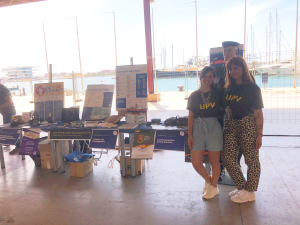
El pasado sábado, 10 de junio, se celebró en el Tinglado número 2 del Puerto de Valencia la Feria de los Inventos de la UPV 2023.
La edición de este año se ha centrado en las innovaciones en alimentación, sostenibilidad, salud, construcción o motor. Los estudiantes de la universidad han llevado a cabo el desarrollo de drones o productos saludables como un aperitivo de pétalos o un helado de algarroba; “fármacos” contra la sequía, alimentos impresos en 3D, monoplaza de competición, robots educativos, edificios y puentes que no se caen, entre otros objetos innovadores.
Fueron 30 los expositores de resultados del trabajo de personal investigador de la UPV, alumnado y titulados/as de la universidad que entienden la divulgación como una de las etapas de la investigación más importantes en el proceso de la innovación y la creación y diseño de productos.
El rector de la UPV visitó el evento y manifestó la falta de vocación tecnológicas y la necesidad de que haya más ingenieros, señalando, específicamente, el pleno empleo en muchas titulaciones de ingeniería del a UPV.
José Capilla, rector de la UPV también hizo especial hincapié en la valoración y necesidad de realizar talleres divulgativos e interactivos para los niños, considerándolos el futuro de la ciencia.
Cátedra UNESCO Forum Universidad y Patrimonio Cultural UPV estuvo presente en la Feria, con uno de los stands, dedicado a Ocean Art Project, proyecto de investigación que persigue la divulgación del conocimiento del patrimonio cultural y natural marino en infancia y juventud. El stand de OAP contaba con la colaboración del Museo de Telecomunicaciones de la UPV, el Museo Histórico Militar de Valencia y la Asociación de Amigos del Museo Militar de Valencia.
En la muestra expositiva, se pudo observar la evolución desde el siglo XIX al siglo XXI de las telecomunicaciones marítimas, desde cables submarinos de 1930, hasta telégrafos, Morse, telefonía y fibra óptica. También se pudo ver una pincelada de la ayuda a la navegación con el lenguaje de banderas náuticas, el radiofónico o el alfabeto semáforo. La Asociación de Amigos del Museo Militar de Valencia cedió un uniforme original de infantería de marina de 1987 y una radio británica de campaña de 1947.
A través de este pequeño recorrido museístico, en el mejor de los escenarios que se podía tener, quedó patente la necesidad de divulgar todo el patrimonio tecnológico que rodea a las telecomunicaciones marítimas, permitiendo que los niños y adultos curiosos se acercaran a disfrutar de piezas de museo únicas.
__
OCEAN ART PROJECT’S SUCCESS AT THE INVENTION FAIR 2023
Last Saturday, June 10, the UPV Inventions Fair 2023 was held in the Tinglado number 2 of the Port of Valencia.
This year’s edition focused on innovations in food, sustainability, health, construction or engine. The students of the university have carried out the development of drones or healthy products such as a petal snack or carob ice cream; “drugs” against drought, 3D printed food, single-seater racing, educational robots, buildings and bridges that do not fall, among other innovative objects.
There were 30 exhibitors of the results of the work of UPV research staff, students and graduates of the university who understand the dissemination as one of the most important stages of research in the process of innovation and the creation and design of products.
The rector of the UPV visited the event and expressed the lack of technological vocation and the need for more engineers, pointing out, specifically, the full employment in many engineering degrees of the UPV.
José Capilla, rector of the UPV also made special emphasis on the value and need for informative and interactive workshops for children, considering them the future of science.
UNESCO Chair Forum University and Cultural Heritage UPV was present at the Fair, with one of the stands, dedicated to Ocean Art Project, a research project that aims to disseminate knowledge of cultural and natural marine heritage in children and youth. The OAP stand had the collaboration of the Telecommunications Museum of the UPV, the Military History Museum of Valencia and the Association of Friends of the Military Museum of Valencia.
The exhibition showed the evolution of maritime telecommunications from the 19th to the 21st century, from submarine cables in 1930, to telegraphs, Morse, telephony and fiber optics. It was also possible to see a brushstroke of the aid to navigation with the language of nautical flags, the radiophonic or the semaphore alphabet. The Association of Friends of the Military Museum of Valencia loaned an original marine infantry uniform from 1987 and a British field radio from 1947.
Through this small museum tour, in the best of scenarios that could be had, the need to disseminate all the technological heritage surrounding maritime telecommunications was evident, allowing children and curious adults to come and enjoy unique museum pieces.
__

